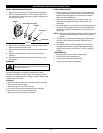
10
To reduce the chance of material wrapping around the blade,
follow these steps:
• Cut at full throttle
• Swing the unit into material to be cut from your left to your
right (Fig. 29)
• Avoid the material just cut as you make the return swing
WARNING: Do not sharpen the cutting blade.
Sharpening the blade can cause the blade tip to
break off while in use. This can result in severe
personal injury to yourself or others. Replace the
blade.
WARNING: Do not clear away any cut material
with the engine running or blade turning. To avoid
serious personal injury, turn off the engine. Allow
the blade to stop before removing materials
wrapped around the blade shaft.
OPERATING INSTRUCTIONS
WARNING: To prevent serious injury, never
perform maintenance or repairs with unit running.
Always service and repair a cool unit. Disconnect the
spark plug wire to ensure that the unit cannot start.
FREQUENCY MAINTENANCE REQUIRED SEE
Before starting engine
Fill fuel tank with fresh fuel
Check oil
p. 6
p. 12
Every 10 hours Clean and re-oil air filter p. 13
1
st
change at 10 hours
Change at 25 hours
Every 25 hours
Change oil
Change oil
Clean spark arrestor
p. 12
p. 12
p. 16
10 hours on new
engine
Every 25 hours
Every 25 hours
Check rocker arm to valve
clearance and adjust
Check rocker arm to valve
clearance and adjust
Check spark plug
condition and gap
p. 14
p. 14
p. 15
MAINTENANCE AND REPAIR INSTRUCTIONS
MAINTENANCE SCHEDULE
Perform these required maintenance procedures at the
frequency stated in the table. These procedures should also be
a part of any seasonal tune-up.
NOTE: Some maintenance procedures may require special
tools or skills. If you are unsure about these
procedures take your unit to any non-road engine
repair establishment, individual or authorized service
dealer.
NOTE: Maintenance, replacement, or repair of the emission
control devices and system may be performed by any
non-road engine repair establishment, individual or
authorized service dealer.
In order to assure peak performance of your engine, inspection
of the engine exhaust port may be necessary after 50 hours of
operation. If you notice lost RPM, poor performance or general
lack of acceleration, this service may be required. If you feel
your engine is in need of this inspection, refer service to any
non-road engine repair establishment, individual or authorized
service dealer for repair. DO NOT attempt to perform this
process yourself as engine damage may result from
contaminants involved in the cleaning process for the port.
Fig. 28
Fig. 29


















